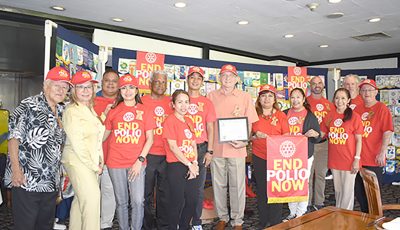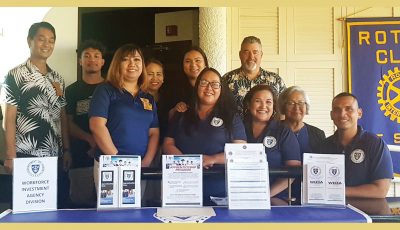Archaeologist welcomed at Rotary Club meeting
Dr. Christopher King, archaeologist and owner of Pacific Bioarchaeology & Forensic Services, LLC, was welcomed as a guest speaker at the Rotary Club of Saipan meeting yesterday at the Hyatt Regency Saipan Ballroom. King presented to the Rotarians his findings related to pre-Spanish contact NMI history through discovered artifacts.
Some topics that King presented included a brief explanation of what the Pre-Latte, Transitional, and Latte Periods of the Marianas were, a look into what the societal structure and diets of these ancestral peoples were most likely to have been, clan burial clusters, and photos of artifacts he has previously unearthed.
For scholarly purposes, the “Latte Period” roughly refers to the time when the people of the Marianas started building house structures that were elevated on stone pillars, or latte. As such, the Pre-Latte period was from about 1500 B.C. to 1000 A.D., the Transitional Period—a time period where the population began to increase and the people moved inland due to advancements in agriculture but before the building of lattes— was from 400 B.C. to 1000 A.D., and the Latte Period was from 1000 to 1668 A.D. The Spanish claimed the Marianas for Spain in 1565.
King also shared with the Rotarians that it was highly likely that the Marianas’ natives were part of a matrilineal society with clan alliances for control and distribution of resources, and that the protein sources for the natives from pre-Latte to Latte included birds, fruit bats, turtle, crab, shellfish, fish, and rat. Missing from their diets until late into the Latte Period, King noted, was the presence of pig, dog, and chicken.
Finally, King shared at the meeting his past findings of clan burial clusters and photos of artifacts including pottery, sling stones, spearheads made from bone and shell, and large mortars made of basalt rock. Most interestingly, King showed pictures of the skeletal remains of an individual’s jaw, with the teeth stained a noticeable red. King shared that more than 50% to 60% of the adult remains he has studied exhibited teeth staining due to the chewing of betel nut, and that betel nut chewing was a double-edged sword: while the chewing created a highly acidic environment in the mouth that dissolved sugars and bacteria and prevented cavities, it also dissolved gums and caused tooth loss through gum disease.
While only becoming a full-time Saipan resident in February this year, King has previously done archaeological work in the NMI, the Northern Islands included. Most notably, King was part of a collaboration with the Japanese Association for Recovery and Repatriation of War Casualties on Tinian and conducted archaeological research on the Imperial Pacific International (CNMI) LLC project site prior to the casino being built.



























